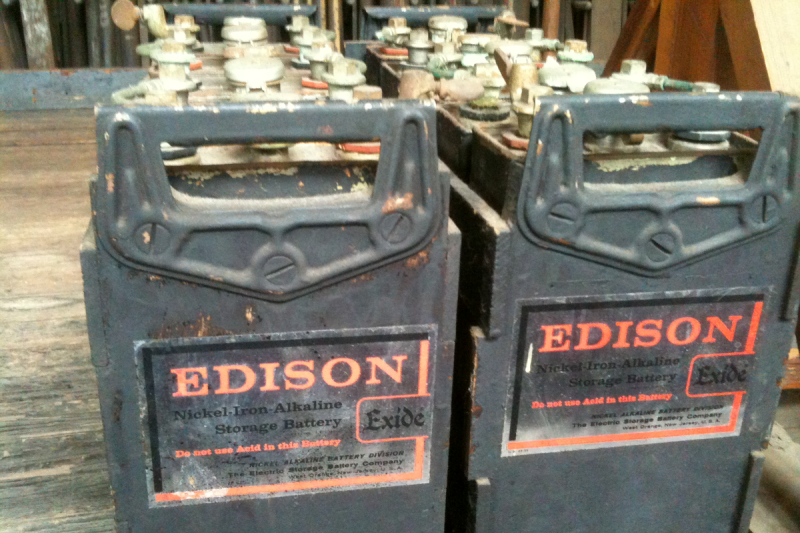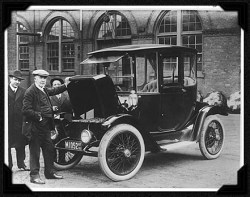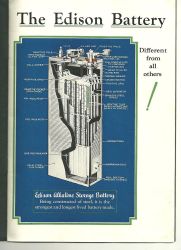Electric Vehicle 1900’s Style: New Leases on Old Tech

Excited about your new electric vehicle? Thomas Edison would be, too. He tried to produce electric vehicles for Ford around 1900. Petroleum-based vehicles dashed his dreams of the electric car, and the battery he wanted to use languished as a technological dead end. The batteries were long-lasting, sure, but they were expensive and had other problems, not the least of which was producing hydrogen gas. But that battery technology is receiving renewed interest today, because some of the things that made it a bad car battery make it good for alternate energy projects.
You wouldn’t think a century-old battery technology that was never very popular would make a comeback. But then again, who thought we’d see the return of bell-bottom pants or vinyl records?
Edison’s Car

Even 90 years after his death, Thomas Edison is still a household name. Why not? He invented — or at least popularized — quite a number of things we take for granted in the modern world. Apparently, he was ahead of his time in at least one area: electric vehicles. The first electric vehicle was an electric tricycle plying the streets of Paris in 1881 and Englishman Thomas Parker took an electric car into production in 1884. According to a recent BBC article, Edison and others had electric vehicles around 1900. There were even electric cabs in London and New York. But Edison’s electric car was a bit different.
Most electric vehicles in those days used lead-acid batteries — a technology still with us in normal cars, although now in a more refined state. These vehicles were probably more like what we would think of today as golf carts. But Edison’s car used a nickel-iron battery that had been around since 1899, the work of Swede Ernst Waldemar Jungner, who also invented the NiCad battery.
Edison had a deal in place to produce electric vehicles for Ford using the batteries. He claimed that they were extremely resilient, lasting in some cases up to 40 years, and charged twice as fast as conventional cells of the day. They were, however, larger and more expensive. They also had an undesirable byproduct of hydrogen gas. By the time Edison was ready with his new battery, petroleum-based cars had caught on, and no electric Ford vehicles would ever issue from the deal.
The Edison Storage Battery Company made these batteries up until 1972. The company passed to Exide Battery, which produced them until 1975.
Nickle-Iron Today

Today, however, the battery tech is resurging. A research team at the Delft University of Technology noticed that the battery charging process was similar to breaking down water, as both processes generate hydrogen and oxygen. It turns out that using the batteries to directly electrolyze water increased the battery’s energy storage and efficiency. The hydrogen gas created as a byproduct is also usable as an energy source.
The team thinks this has applications in storing intermittent power sources such as wind or solar. Storing energy in lithium-ion batteries, for example, is great until the battery is full. Then you have to disconnect to prevent overheating which will shorten the life of the cells. A nickel-iron battery, however, is fine fully charged, and using this new innovation can transition to producing hydrogen gas to handle the excess energy put in. The battery can work more efficiently than a traditional electrolyzer. The only downsides are higher internal resistance than some other battery technologies and lower charge retention times. However, some of these problems have been mitigated by adding carbon.
At Scale
A current prototype handles about 15 kWh, but one twice that size is under construction. They hope to eventually to scale the batteries up nearly 100 times. The batteries did not completely disappear after Edison. Their long life and tolerance of abuse such as overcharging and short circuiting have made them popular in applications where they need a long service life. Some subway trains, for example, use this type of battery. The German V2 rocket also used them.
One benefit to nickel-iron is that while they are expensive to produce, it isn’t because of rare materials. We have plenty of nickel and iron. Disposing of nickel and iron isn’t particularly problematic, either. If you want to learn more about the battery technology, there’s an entire website from the Nickel Iron Battery Association that includes a 1912 electric car that claims to have a working battery still, over 100 years later. You can also find a scan of Edison’s 1914 manual on caring for their batteries. You can even try making your own battery at home, if you watch the video below.
Mining History

It makes us wonder what other old tech is sitting around waiting for some improvements and a change in conditions to make them successful? After all, if you told Edison you wanted his batteries to produce hydrogen, he’d have probably thought you were crazy.
I have to admit, I sometimes thumb through old electronic magazines for inspiration. Sometimes it is pretty indirect, but it is amazing what people were doing with what we think of now as very little. It also amazes me how many things we think of as modern were being done much earlier than you would guess. Fax machines, video, computers, and data searches all existed way before they became mainstream. Sometimes the technology just has to wait for people to catch up to it.
Post a Comment